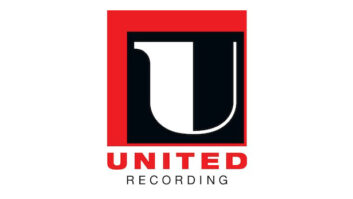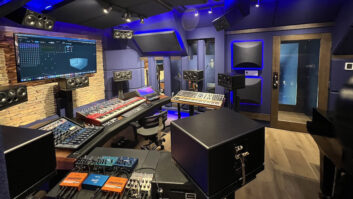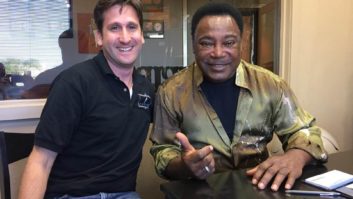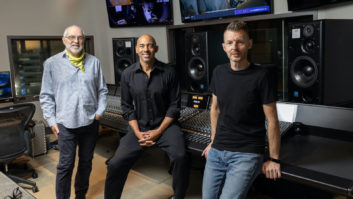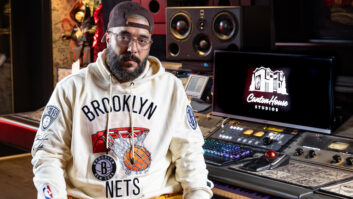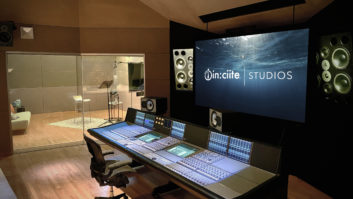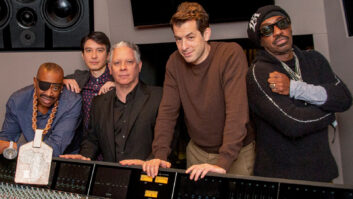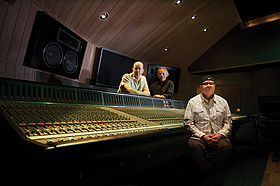
Owners Adam Beilenson (left) and Mike Kerns in Encore Studio A with film music mixer Joseph Magee (The Muppets, Hannah Montana, Jonas Brothers, Spiderman 3; seated)
Photos: GorgeousDigital.com
Adam Beilenson and Mike Kerns, co-owners of the Paramount Recording Group, the biggest music-dedicated studio operation in L.A.—and quite possibly the biggest on the planet—have gotten to this point by boldly bucking trends.
Tellingly, the Paramount Group began to hone its competitive edge in 2000, the year after Napster appeared, sending the music business reeling and dealing a devastating blow to the recording sector as a direct consequence. At that critical juncture, Beilenson and Kerns, a pair of ex-musician L.A. natives who’d opened Hollywood’s Paramount for business 14 years earlier, made a move that seemed foolhardy at the time, buying Ray Parker’s Ameraycan Recording in North Hollywood. Four years later, just as prices were bottoming out post-downturn, they snapped up Encore, formerly part of the storied Kendun complex on Glenwood Place in Burbank. In 2008, they purchased Track Record, built in 1980 by producer Brian Ahern for his then-wife Emmylou Harris. Just last year, they added a fifth facility, acquiring Wilder Brothers in Century City, where film composer Henry Mancini once worked. (Mancini’s piano is still on site.)
“We’ve also bought and sold a few other studio properties over the years, as well as doing some other real-estate deals together outside of the studio business, including vacation rental properties in Venice Beach where we often put up out-of-town studio clients,” says Beilenson, sitting at his desk at the group’s command central just off the entryway of Paramount Recording. “Some of those investments did well, and it afforded us the opportunity to buy these other facilities. These are all interesting studios that really did well at one time, but then they went downhill for one reason or another. And one of the reasons why we were able to buy low was purely by virtue of the fact that there weren’t a lot of prospective buyers out there. Some of these studios were on the market for a long time, but that was not reflective of their quality as studios; they were as premiere as you could get—and the hardware came with it, although we did the necessary upgrades.”
The addition of Wilder Brothers brings Beilenson and Kerns’ empire to 11 SSL mixing and tracking rooms, along with 20 production rooms, following their canny transformation of pretty much every square foot of available space in their various facilities into income-producing units. At the same time, they’ve styled up every one of these 31 rooms in response to the standards of their current clientele. This operation is a case study in economies of scale.

From left: Producer/mixer Neal Avron (Linkin Park, Fallout Boy, Sara Bareilles, Blink-182) in Paramount Studio A with chief engineer Tom Doty and studio manager Megan Milius
These physical changes represent the duo’s proactive responses to a dramatically changed music business—a new paradigm, as they put it. “The control of the budgets is now largely in the hands of the music producers, not the labels,” Beilenson points out. “These are not the traditional producers we saw during the rock era; they’re writing the music and then producing the acts. J.R. Rotem, The Stereotypes and Harvey Mason Jr. are perfect examples. They want their spaces to look like modern, high-end boutique hotels, and that’s what we’ve aimed for. We believe the collaboration between our chief tech, Tom Doty, and Jack Viera of Pirate Acoustics succeeded in melding style, function and design for the modern recording era.”
Beilenson is quick to point out that the 20 small rooms are production studios. “We’ve made large investments in these rooms with the long-term outlook in mind. They’ve got vocal booths, they have professionally built acoustic treatments on walls and ceilings, we installed double sound doors, and because the spaces are pre-wired, they can plug right in. That’s the nature of our business today.”
Paramount’s winning formula is simple but inclusive: provide state-of-the-art spaces at competitive prices for all manner of clients, from budget-conscious producers and musicians who book smaller rooms in 4-hour-minimum increments to movers and shakers. Of the latter group, Dr. Dre has had a lockout on both rooms at Encore for two years running; Mason Jr. is Track Record’s long-term tenant; and Rotem (Britney Spears, Nicki Minaj, Jason Derulo, Sean Kingston, Beluga Heights) is camped out in Wilder Brothers Studio A, while The Stereotypes production team works continuously in B.
Traditional music-biz clients haven’t completely disappeared, however. Sony/ATV Music Publishing leases a second-floor alcove above Paramount’s back patio that’s been dubbed the Tree House; the previous tenant was Atlantic Records. And in October, new Epic Records head L.A. Reid booked three of Paramount’s tracking rooms and four production studios for a 5-day, around-the-clock writing camp, in 8-hour shifts, with such heavies as Polow Da Don and Tricky Stewart participating. “It was like back to the Brill Building,” says Beilenson. “I’m told it was incredibly productive. And Polow hasn’t left—he fell in love with C.”
Beilenson and Kerns are D.I.Y. to the max, and that willingness to get their hands dirty, they believe, is the key to their ongoing success. “We’re extremely hands-on,” says Kerns. “You’re not dealing with a studio manager, you’re dealing directly with us. We’re trying to be very agile in every aspect of the business. We look at everything, we’re here every day, we see all our clients every day and they enjoy it. Our big thing is, we always answer the phone, 24 hours a day. We’re small-business owners; we don’t have a rich dad or mom. Every day it’s a few bucks—if we can make it happen, let’s do it.”
“This business is based on immediacy,” Beilenson adds. “A lot of bookings are last-minute, and as a result, the more available the decision-makers are, the better you’re going to do. We’re hard workers; we have been for 26 years. We work seven days a week. If there’s a slogan to describe us, it’s this: We do whatever we have to do to be able to say yes to everybody.”
“We’ll eat a bug!” Kerns interjects with a laugh, referencing the iconic line of SoCal used-car dealer Cal Worthington in his local TV spots.
“Not to sound boastful, but we have an insane number of clients, a critical mass, just due to the volume that we’ve done for 26 years,” Beilenson continues. “We’re talking about 31 rooms with a client or a tenant in it every single day. That’s a huge number of people, and in a relatively small business that’s a lot of market share.”
So what’s next for Paramount?
“We want to continue our expansion,” says Beilenson. “We have our eyes on other facilities. At this stage, we’re well positioned to acquire places and immediately turn them into profitable situations because our overhead is going to be tiny relative to anybody else. So we’ll always be looking for those kinds of situations. We’re ready to pounce. Whatever it takes.”
